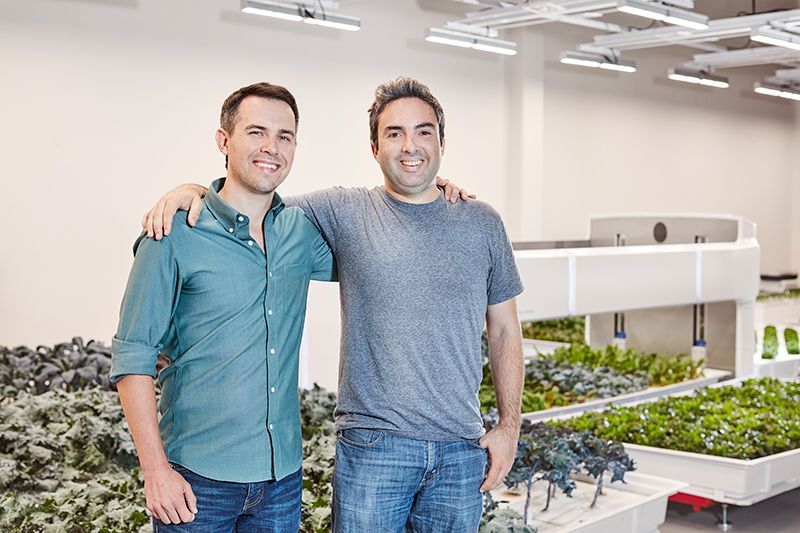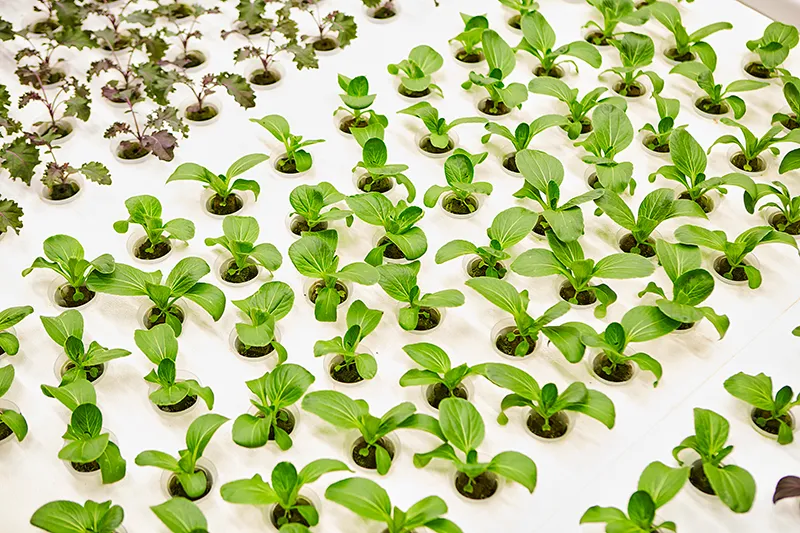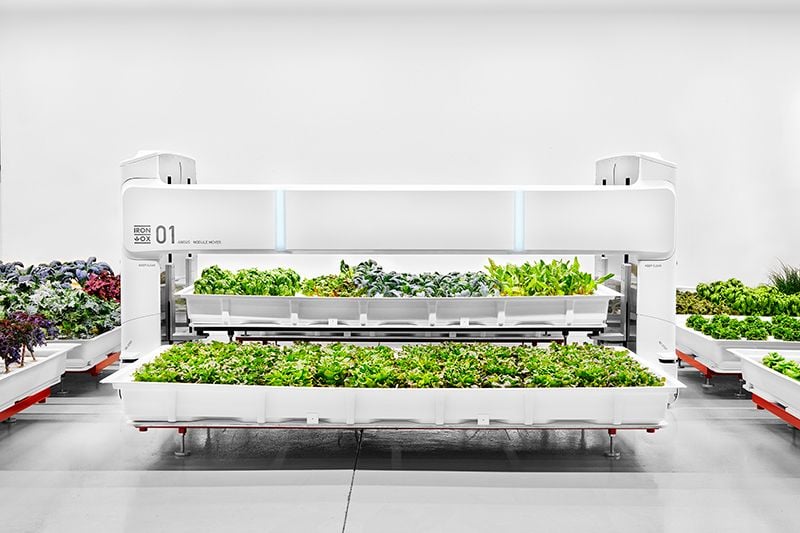This Robotic Farming System Could Be the Answer to Labor Shortages
Hydroponics startup Iron Ox is automating indoor produce farming
/https://tf-cmsv2-smithsonianmag-media.s3.amazonaws.com/filer/18/c7/18c70b2d-d71e-4c6b-ba44-0eb4e1051a65/transplanter_hero.jpg)
Brandon Alexander grew up on farms, acres and acres of wheat and other broad acre crops in Texas and Oklahoma. So, it’s not entirely surprising that he applied his other expertise—based on a robotics degree from the University of Texas and work at Google X—to some of the biggest issues facing modern farmers: water use, labor shortages and total yield.
Iron Ox, which Alexander co-founded with Jon Binney, uses two robots and a cloud-based “brain” to grow lettuce, tomatoes, basil and more in a hydroponic system in its first production farm in San Carlos, California—a facility they claim is the first indoor, fully autonomous robot farm. The company, which started in 2015, is now growing 8,000 square feet of produce, and plans to begin selling to chefs and restaurants later this year, then local grocery stores in 2019. Eventually, the startup wants to open farms across the country, offering local produce year-round.
Are robots the future of farming? Why isn’t everybody doing it? And why is the little one with two eyes so cute? Alexander walks us through his new robot-to-table method.
Let’s start with the problem. What problem are you trying to solve with Iron Ox?
There are three macro problems that we’re trying to solve at the same time. One is access to fresh produce. Right now the average travel distance for strawberries, tomatoes, a head of lettuce, is 2,000 miles. And that’s because farming, right now, is highly centralized to just a handful of counties in the entire United States. What we want to do is decentralize farming, so we can grow close to the consumer.
The other big issue facing agriculture today is labor scarcity. The average age of a farmer is 58 years old. We’re finding that newer generations, not just in the United States but across the globe, are not taking up agriculture. There’s a multibillion-dollar loss right now because there’s not enough people to do the work.
One of the big things that we’re concerned about too is food deserts and how you can sustainably provide fresh produce to everybody. And that’s one of the reasons we selected hydroponics for our growing, because it not only can reduce the carbon dioxide emissions by growing locally, but we can also use 90 percent less water.

How did you hit on the combination of hydroponics and robotics?
My cofounder and I have a fair amount of experience doing robotics at places like Willow Garage and Google X. I actually come from a pretty large farming family. We spent months just talking to farmers and just understanding the landscape—outdoor farms, indoor farms, all different approaches. Hydroponics, aquaponics, vertical farms, we tried to take a broad look at everything before we selected our approach. There’s been a significant amount of technology improvement on outdoor farms, even in the past five years. Cheaper sensors, cloud computing, more robust machine learning algorithms, so on. Fresh produce hasn’t really seen the same level of technology that a lot of broad acre processed crops have, like corn, soybeans, wheat, and so on. So that’s really where we felt there was a real opportunity to innovate.
Greenhouses, indoor farms, they can help grow locally, but they’re still very labor-intensive processes. What we tried to do was reimagine the farm, taking all the learning from the past, but also combining it with state-of-the-art robotics and machine learning. To really redesign the process around robotics. Hydroponics allows us to grow year round, but the robotics allows us to constantly monitor our produce for a more consistent product. So, it shouldn’t matter what time of the year, it should always be this peak quality produce, as if it was—and it will be—harvested that morning.

Can you dig a bit into the tech in the system? What else are you doing that’s innovative?
We have two different robots. A large mobile robot, Angus, is constantly navigating through our farm looking for what’s going on at a macro level. And then we have this robotic arm with a stereo camera, kind of like your eyes. The depth image allows it to see each head of lettuce, or each crop, in full 3D.
We’re using computer vision based on machine learning to recognize warning signs of powdery mildew, or aphids, or tipburn, and then our cloud-based brain can actually take data from the farm, like ph level and temperature sensing, and make a decision on what the issue is and the corrective action to be taken.
Hydroponics has been around. We’re big believers in it from a sustainability perspective, but we had to customize our setup to be robot friendly. We ended up with these grow modules—they’re basically four foot by eight foot hydroponic systems that weigh roughly 800 pounds, with water and nutrients, everything the plant needs to live and thrive. Every day, one of these modules needs an operation—a feeding, an inspection or harvesting. Angus, which weighs a thousand pounds, is commanded by our “brain” to do an operation, like “Hey, this hydroponic module 14 has some purple bok choy that needs harvesting.” And so Angus goes over and picks up this hydroponic system and then it brings it over to our robotic arm. And then our robotic arm knows, OK, this is a harvesting operation. It scans this module, and it figures out where every head of lettuce is, where every leaf is and it does that harvest, or a transplant operation. The robots don’t have to do their job autonomously. This cloud-based brain is constantly deciding how it should happen, basically optimizing the farm.
So what are some of your biggest remaining challenges?
Can we grow great produce? And that’s where our head of growing, Nicole Bergelin, and her team have been fantastic. Yes, the robots are great, but ultimately, we’re a farm, and it’s about the produce. One thing we do is internal blind taste testing of our produce. We buy off the counter from great grocery stores, and then we compare it to ours. We always make sure that we’re capturing qualitative data of, not just taste, but appearance, texture, crispness, bitterness, sweetness, all these different attributes.
When Nicole took over, there was a significant improvement in our yield and quality. And a big part of that was, she gave every head of lettuce, every kale, every basil, tons of attention per day. So we’ve been working with her on how we can encode her knowledge and what she’s looking for into our robots to do a lot of monitoring for her.

Your food isn’t for sale yet, right? What has to happen to make that possible?
We’ve been talking with chefs, understanding their needs, but we haven’t been pitching to them or selling to them yet. Now that we’ve launched our robotic farm, we’re going to start inviting chefs, of local restaurants and so on, to visit our farm and try out the produce for themselves, with the goal of selling later this year. In 2019, we expect to expand to grocery stores.
Robots are cool and all, but what makes using them on a farm so important?
In some ways, this just has to happen if we’re going to feed the growing population. There’s labor scarcity, but at the same time we’re noticing a plateauing of yields in our outdoor farms. One of the reasons we took this more radical approach is because we felt, if we’re going to do something to increase the world’s food production, we had to take a more drastic path to do it. It can’t just be an incremental improvement.

